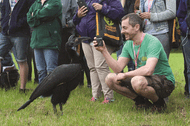The Third Animal Training Conference
Posted by Animal Training Conference, Third Animal Training Conference, Animal Training on 9/4/2025
Mike Simmons reviews the animal training conference.
An early morning start with a 120 mile journey ahead and a weather forecast of thunder storms and showers was just the beginning of it. The birds loaded up into their travel boxes so well, even though it was two hours before they usually awake. We set off and hit the road. I say we because I was accompanied by our Patagonian Conures, Ground Hornbill, Saker Falcon, Bald Eagle and Burrowing Owls.
Journey
Twenty minutes into our journey and the clutch went on our car. My midday slot for my presentation was unlikely as a recovery vehicle was hours away.
Mike was demonstrating at the event for the first time. His display in winter last year had to be called off due to bad weather.
Half our initial team of birds went home and my personal car could carry a few birds, so we set off for a new slot of four o?clock.
Travelling with animals can be stressful enough without the thought in the back of your head that you are to be presenting free flying birds in a new location, to some of the world?s most respected animal trainers that have travelled from twelve countries to watch.
Experts
Some of the other experts displaying at the event included Steve Martin of Natural Encounters, respected trainer Ken Ramirez and Conservation Dogs.
The aspect I enjoy the most about presenting is the overall challenge of pulling everything together to a standard that you are pleased with.
Apart from turning up with far fewer birds then anticipated and in a plain family car instead of your sign written van, I couldn?t have been prouder of my birds which were so professional.
The aim of the international animal training conference is to showcase different groups of animal training, so literally there was presentations on everything from butterfly?s and fish to police dogs and dolphins.
Our Patagonian Conures helped me present some theories behind free flying birds and also included in the demonstration was a Northern Ground Hornbill.
Mike has demonstrated at many other shows, including Think Parrots and The Pet Show.
Methods
The concept that starvation is what prevents the birds from flying off is most people?s primary belief. My methods focus more so on trust and relationship building.
Food rewards are used as a positive reinforcer, however the birds enjoy these favourite pellets, fruits and nuts in the same way as we treat ourselves with the equivalent of fine chocolates or expensive wines.
These treats for the birds are rewards for hard work and send the same message as putting up your feet on a Friday night with your chosen tipple. Placing the timing of the rewards to follow hard work or a chosen behaviour is positive reinforcement training, without knowing it we humans are all training ourselves by these methods on a daily basis by rewarding ourselves.
We condition ourselves to look forward to getting home from work and in comparison the birds should go back to cages and travel boxes with the same mind set.
Training
Training is quite simple and the science and application is relatively simple when you can connect to the concept of it. Although we shouldn?t fully compare the needs of our birds to ourselves, primarily as living creatures our needs are simple and very much the same.
The birds proved the relationship building process by searching for myself in hidden crowds and playing a bird form of hide and seek. This means we condition the birds to find the trainer and are rewarded for doing so.
This helps the birds find us should they get slightly lost or disorientated in flight. This method proved itself really useful as Zumba our Ground Hornbill in play flew too far over a dense hedge line. Unable to get through to look for her, she relocated the area she came from and found the audience and myself.
All in all it was superb to meet a group of international trainers and present our birds to them, but as much as we loved our day the birds and I were happy to get home.
Message
I guess that?s my message to you, I love going to work and love getting home. For the birds too it?s important to want to participate in life?s activities in the same way.
If they don?t then the jobs we are asking them to do or places we want them to go like a cage for example are not balanced or the rewards are not desired enough. It is our job as their keepers to create contentment whether they are at work, rest or play.
For more information about why flying is important to birds, read one of Mike?s other blogs ?here.
Have you ever attended an animal training conference?





